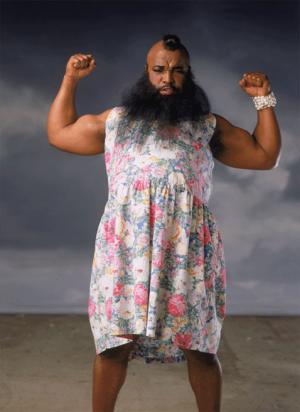This is the last PoP feature I’m going to run. As popular as this feature has been (??!), it’s time to wind it up and move on to other distractions. In fact, I was going to stop at the top 5 but I know that all those PoP-lovers out there (??!) have been waiting for one face to turn up. Or should that be, one “Face” to turn up! (Ga-zing!) That’s right, the tied-for-6th-position inductees into the Pantheon of Plastic are Dirk “Faceman” Benedict and his A-team-mate, Mr T!
Dirk Benedict

Starbuck, Battlestar Galactica
(TV, 1978; figure released 1978 by Mattel)


Dirk Benedict shot to fame as wisecrackin’ cigar-chompin’ X-Wing pilot James T. Starbuck, fighting the evil Stormtroopers while seeking a final refuge for the Rebel Alliance. For one glorious season he smirked his way through the galaxy, trading gags with the tin dog, and then returning for some TV movies. Benedict hasn’t been pleased by the revival of his classic show, but maybe that’s just sour grapes because a google image search on Starbuck doesn’t feature him nearly as much as it once did, and also includes a giant left-liberal coffee chain. At least he doesn’t have as much to complain about as his old co-star Richard Hatch, whose dogged determination over decades to revive the show was completely thwarted by some other people who came in and re-imagined it. More important source of Hatch disgruntlement: in the 1978 action figure series, they never made one of Captain Apollo. You could buy his best friend, his dad, his enemies and that random insect that was a baddie in one episode, but him, the co-lead? No! Poor Richard Hatch.
Templeton Peck, The A-Team
(TV, 1984; figure released 1984 by Galoob)


Benedict made a similarly lasting impression as the ultimate smooth operator, “Face”/”Faceman” in soldiers-for-hire the A-Team. The team specialised in rescuing kidnapped children, and escaping from fully-supplied mechanical workshops, but Face was basically there to woo the ladies (on-screen ladies, and those watching at home). As a kid I always wondered why he was called Face, because his Face didn’t seem to come off or morph into anything, and as superpowers went “having a face” wouldn’t even get you an interview for the Great Lakes Avengers. Now I understand: it’s because you want to slap his smug face every time he opens his mouth, right? Right?
Mr T.

Clubber Lang, Rocky III
(Movie, 1982; figure released 1982 by Phoenix Toys)


Mr T needs no introduction, for he is loved by all. “Pity the fool” comes from the Rocky III script.
Here is a post from 2007 with some great Mr T amazement.
B.A. Baracus, The A-Team
(TV, 1984; figure released 1984 by Galoob)


Mr T actually makes more sense as an action figure who is made into a person, than as a person who is made into an action figure. Which seems as good a place as any to stop this madness.
So that’s enough of that.
BONUS MEMORY: I will always remember Mr T. from Alex Winter’s bizarro comedy Freaked. As the bearded lady:




















